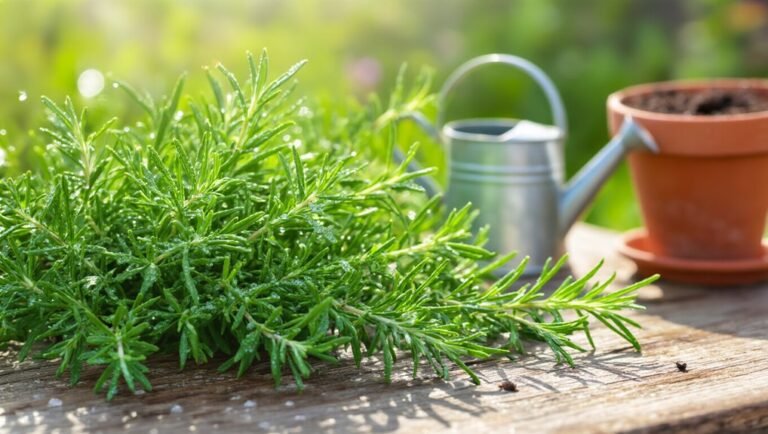To thrive, your rosemary plants need well-draining soil mixed with organic matter. Ensure they get six to eight hours of direct sunlight daily. Water deeply but infrequently, letting the soil dry out between waterings to avoid root rot. Regular pruning encourages growth, while harvesting fresh sprigs promotes bushiness. Watch for pests and manage diseases promptly. If you’re looking to optimize flavor or protect your plants during winter, there’s more to explore ahead!
Key Takeaways
- Use well-draining soil, like sandy soil mixed with compost, to prevent root rot and encourage healthy growth.
- Water deeply but infrequently, allowing the soil to dry out between waterings to avoid soggy roots.
- Ensure rosemary receives at least six to eight hours of direct sunlight daily for optimal growth.
- Prune regularly to remove dead stems and encourage new growth, improving airflow and reducing disease risks.
- Monitor for pests and diseases, maintaining good air circulation and clean growing areas to keep plants healthy.
Choosing the Right Soil for Rosemary
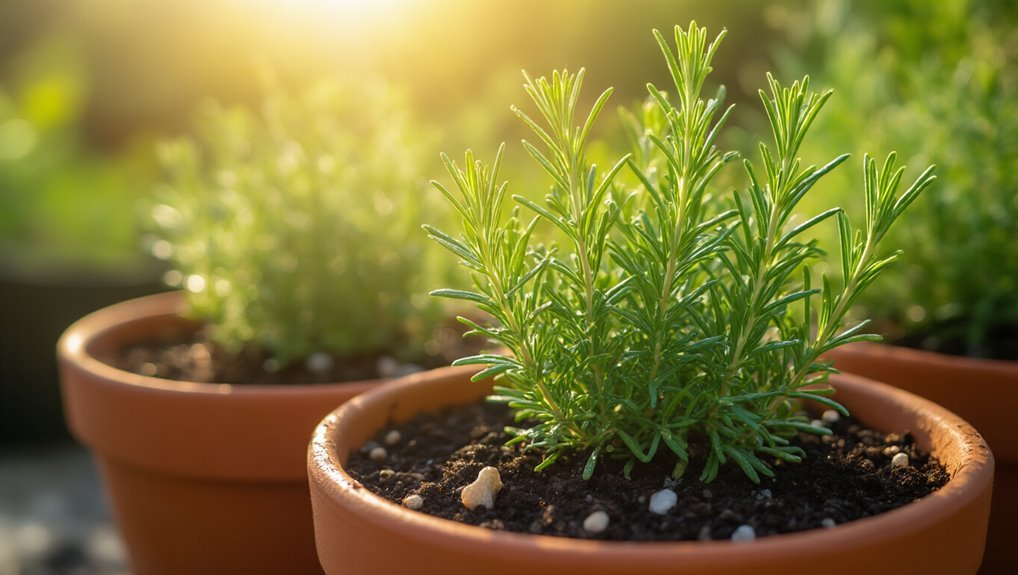
Choosing the right soil for your rosemary plants is essential for their health and growth.
Rosemary thrives in well-draining soil, so opt for a mix that allows excess water to flow through easily. A combination of sandy soil and organic matter, like compost, works wonders. This mix not only provides the necessary drainage but also adds nutrients your plants need. Using mulch in your garden can also help retain moisture while preventing weed growth around your rosemary, ensuring the roots stay healthy.
Avoid heavy soils or those that retain too much moisture, as this can lead to root rot. You might even consider adding perlite or gravel to enhance drainage further.
Test the pH level too; rosemary prefers slightly alkaline conditions, ideally between 6.0 and 7.0.
If you’re looking for the ideal blend, consider using a garden soil that is specifically formulated for thriving plants, as these products are designed to support healthy root development and robust growth.
With the right soil, your rosemary will flourish, providing you with aromatic leaves for cooking and more.
Optimal Sunlight Conditions
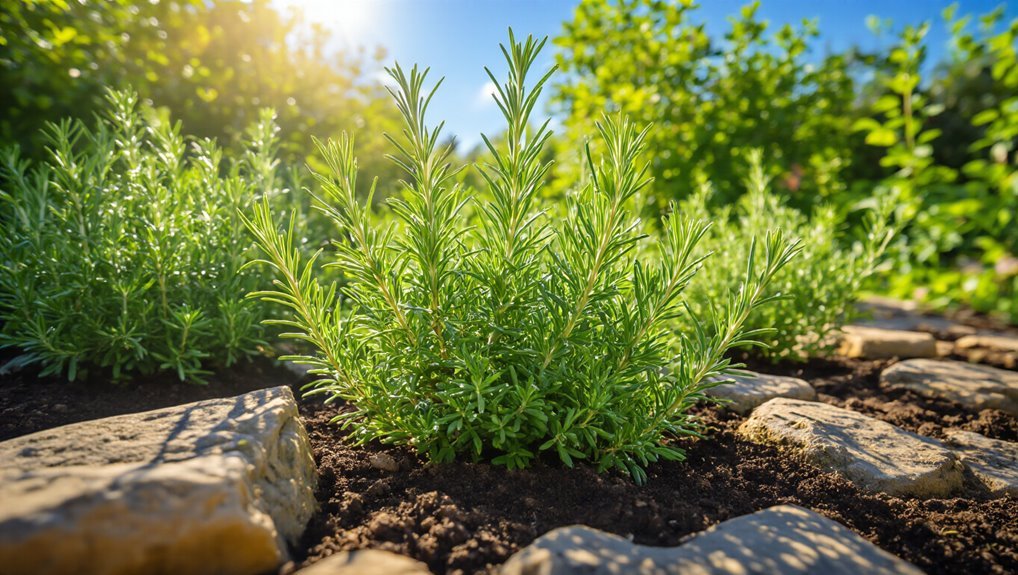
For rosemary to thrive, it’s crucial to provide the right amount of sunlight. Aim for at least six to eight hours of direct sunlight each day.
Placing your rosemary plant in a south-facing window or outdoor garden spot will help it soak up those rays. If you notice your plant becoming leggy or losing its vibrant color, it could be a sign it’s not getting enough light. Using herb garden kits can make it easier to place and move your rosemary to find the best sunlight conditions.
On the flip side, too much intense sunlight, especially in extremely hot conditions, can scorch the leaves. If that happens, consider providing some afternoon shade.
Regularly rotating the plant can also ensure even light exposure, promoting balanced growth. With the right sunlight, your rosemary will flourish beautifully! Starting your rosemary from seed is easier when you use seed starting kits, which provide the ideal environment for healthy seedlings.
Watering Techniques for Healthy Growth
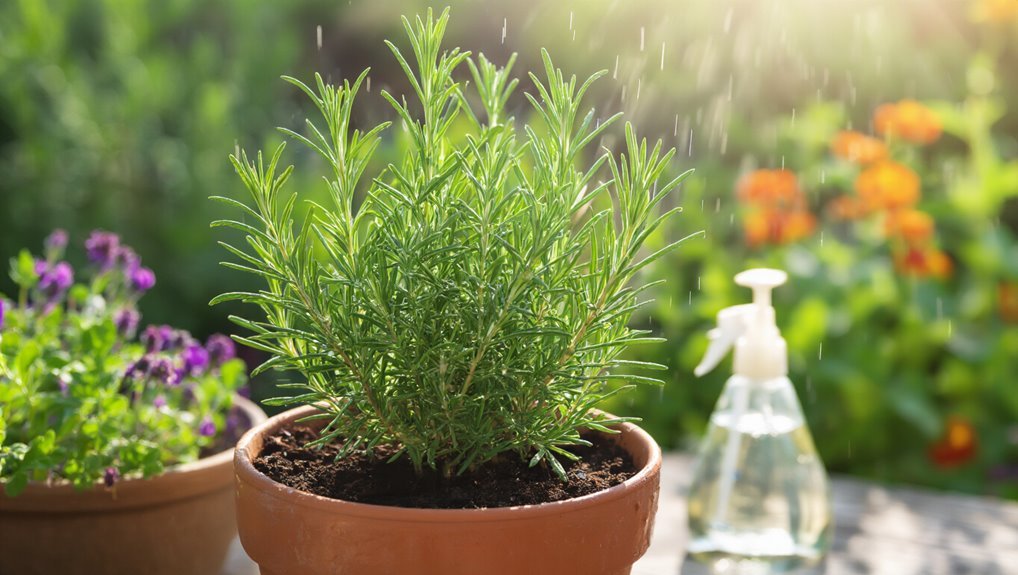
Watering is vital for maintaining healthy rosemary plants, as it directly affects their growth and overall vigor.
To ensure your rosemary thrives, water it deeply but infrequently. Aim for the soil to dry out between waterings; this mimics its natural Mediterranean habitat. Using the right watering cans can help you deliver water directly to the base of the plant, preventing excess moisture on the leaves and reducing the risk of fungal issues.
Check the soil moisture by sticking your finger about an inch deep—if it feels dry, it’s time to water. When you do, soak the soil thoroughly, allowing excess water to drain.
Avoid overwatering, as rosemary doesn’t like soggy roots and may develop root rot. During hot, dry months, you might need to adjust your watering schedule, but always prioritize consistent soil moisture without saturation.
For an easier way to maintain optimal moisture, consider growing your rosemary in self-watering planters, which help regulate soil hydration and reduce the risk of overwatering or underwatering.
With the right techniques, your rosemary will flourish beautifully.
Pruning Your Rosemary Plants

While pruning might seem daunting, it’s essential for keeping your rosemary plants healthy and vigorous. Start by using sharp, clean scissors or pruning shears. Aim to remove about one-third of the plant, focusing on dead or woody stems. This encourages new growth and improves airflow, reducing the risk of pests and diseases.
Don’t be afraid to shape your rosemary; a tidy plant isn’t just prettier, but it also promotes better sunlight penetration. Prune in early spring or after flowering for the best results. For gardeners looking to improve their routine, investing in a gardening tool set can make regular pruning and maintenance much easier and more enjoyable. For the most effective results, consider choosing from essential pruning shears designed specifically for your gardening needs.
Fertilizing for Maximum Flavor
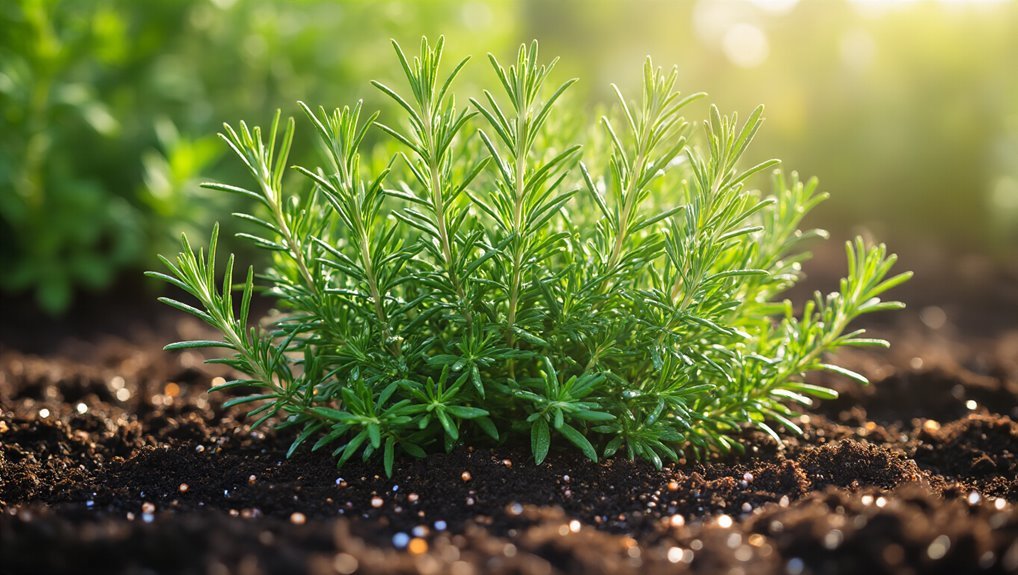
To enhance the flavor of your rosemary, it’s crucial to fertilize it properly. Start with a balanced, organic fertilizer, as it promotes healthy growth without overwhelming the plant. For an easy and mess-free option, you can use Plant Fertilizer Tablets to deliver nutrients directly to the roots.
Apply it during the growing season, typically in spring and early summer, when your rosemary is most active. Aim for a light application every four to six weeks, ensuring you don’t overdo it—too much fertilizer can lead to less flavorful leaves.
Water the plant well after fertilizing to help nutrients penetrate the soil. You can also enrich the soil with compost, which adds essential nutrients and improves drainage. For an easy way to create your own compost, consider using compost bins designed specifically for gardens.
Managing Pests and Diseases
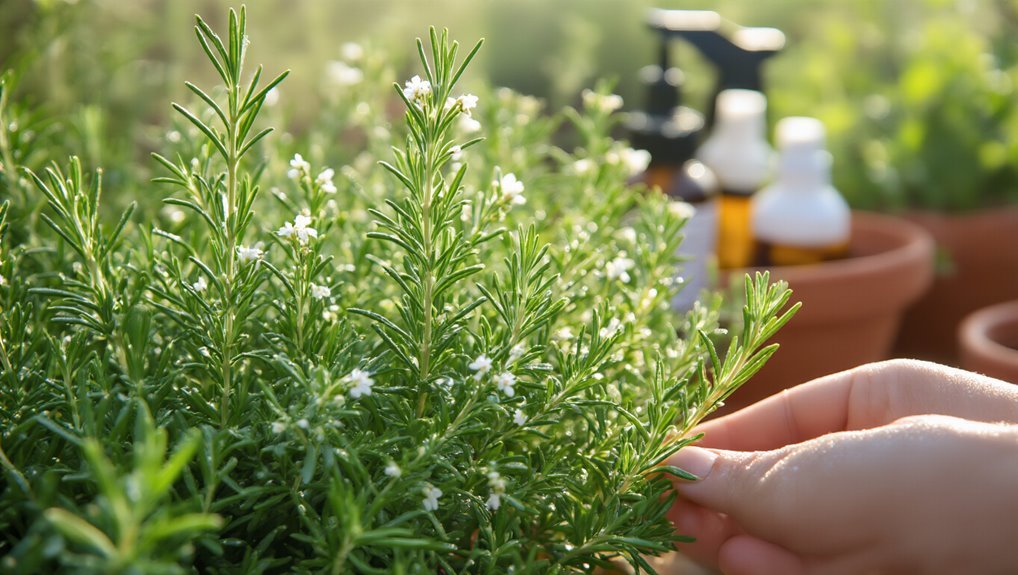
Healthy rosemary isn’t just about proper fertilization; it also means keeping an eye out for pests and diseases that can threaten your plant’s vitality.
Regularly inspect your plants for signs of trouble, like discolored leaves or unusual spots. Common pests include aphids and spider mites, which you can manage by washing them off with a strong stream of water or using insecticidal soap. For a chemical-free approach, you can also use sticky traps to capture flying pests and reduce infestations.
Fungal infections, such as root rot, often stem from overwatering, so ensure your soil drains well. If you spot any affected areas, remove them promptly to prevent spreading.
Maintaining good air circulation and avoiding overcrowding can also help keep your rosemary healthy. For persistent pest problems, consider using effective solutions for pest control products to protect your rosemary plants without harming the environment. By staying vigilant, you’ll enjoy a thriving, pest-free rosemary plant.
Harvesting Rosemary Correctly
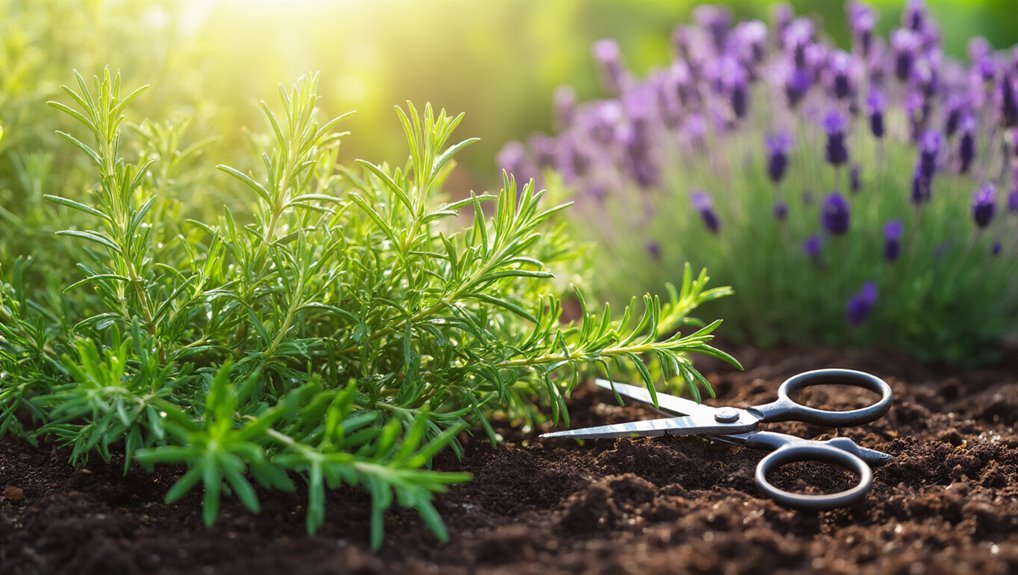
When you’re ready to harvest rosemary, timing is key to ensuring the best flavor and aroma. Aim to pick your rosemary in the morning after the dew has dried but before the heat of the day sets in. This timing helps preserve its essential oils. Using a garden kneeler can make harvesting easier on your knees, especially if you have a large rosemary bush or are working for an extended period. Use sharp scissors or garden shears to snip off the top 2-4 inches of stems, cutting just above a leaf node. This encourages new growth while ensuring a healthy plant. If you need only a small amount, take a few sprigs rather than cutting large sections.
Store your freshly harvested rosemary in a cool, dry place, or use it immediately to enhance your dishes. Remember, the more you harvest, the bushier your plant will become! For the best results and to protect your hands while harvesting, consider using gardening gloves designed specifically for garden work.
Overwintering Rosemary Plants
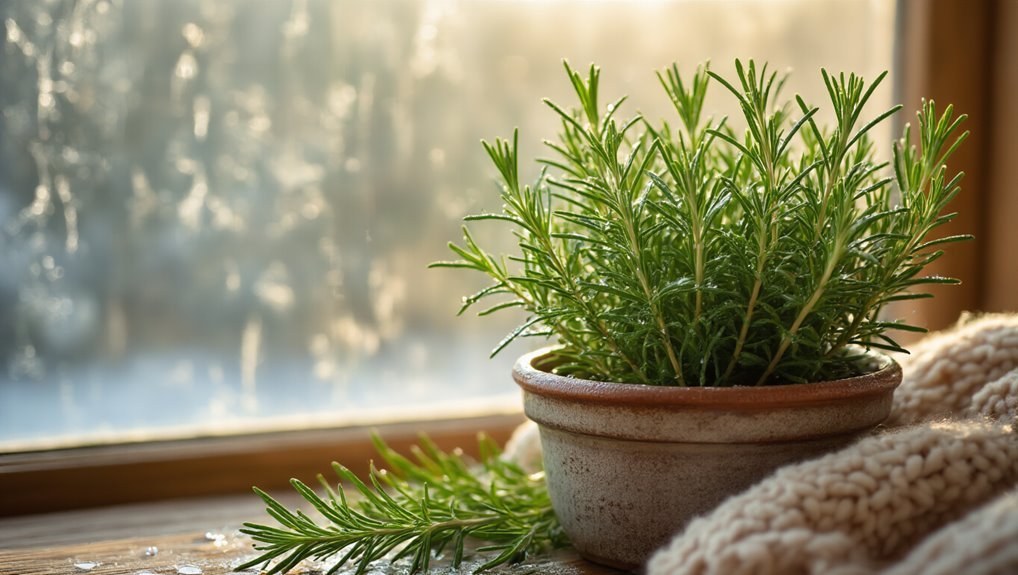
After you’ve harvested your rosemary, it’s important to think about how to care for it during the colder months.
If you live in a colder climate, consider bringing your rosemary indoors. Place it in a bright spot, like a south-facing window, to ensure it gets enough sunlight. Keep the soil slightly moist but avoid overwatering, as rosemary doesn’t like soggy roots. Using a garden hose with a gentle spray attachment can help you control the amount of water your rosemary receives.
If you’re keeping it outside, protect it from frost by covering it with burlap or moving it to a sheltered area. You can also mulch around the base to insulate the roots.
Regularly check for pests, and prune any dead or damaged leaves. One way to prevent overwatering is by using a soil moisture sensor to monitor when your plant actually needs water. With these steps, your rosemary should thrive even through winter.
Frequently Asked Questions
Can Rosemary Grow Indoors Successfully?
Yes, rosemary can grow indoors successfully. You need to provide plenty of sunlight, well-draining soil, and moderate watering. With the right conditions, you’ll enjoy fresh rosemary right from your kitchen!
What Companion Plants Are Good for Rosemary?
Like a symphony in your garden, rosemary pairs beautifully with basil, oregano, and thyme. They share similar growing needs and help each other thrive, creating a harmonious atmosphere that enhances flavor and fragrance in your space.
How Long Does Rosemary Typically Live?
Rosemary typically lives for several years, often ranging from 10 to 15 years if properly cared for. With the right sunlight, watering, and soil conditions, you can enjoy its aromatic presence for a long time.
What Common Mistakes Should I Avoid With Rosemary?
When caring for rosemary, avoid overwatering, neglecting sunlight, and using heavy fertilizers. You’ll want to ensure proper drainage and prune regularly. These common mistakes can hinder your plant’s health and growth significantly.
Can I Propagate Rosemary From Cuttings?
Think of rosemary cuttings like seeds of potential. Yes, you can propagate them! Just snip a healthy stem, place it in water or soil, and watch as new roots grow, transforming your garden into a fragrant haven.
Conclusion
By following these tips, you’ll set your rosemary plants up for thriving growth and bountiful harvests. Did you know that rosemary can grow up to 4 feet tall and live for over 30 years in ideal conditions? With the right soil, sunlight, watering, pruning, and care, you can enjoy fresh rosemary for years to come. Embrace these practices, and you’ll not only enhance your garden but also elevate your culinary creations with this aromatic herb.
